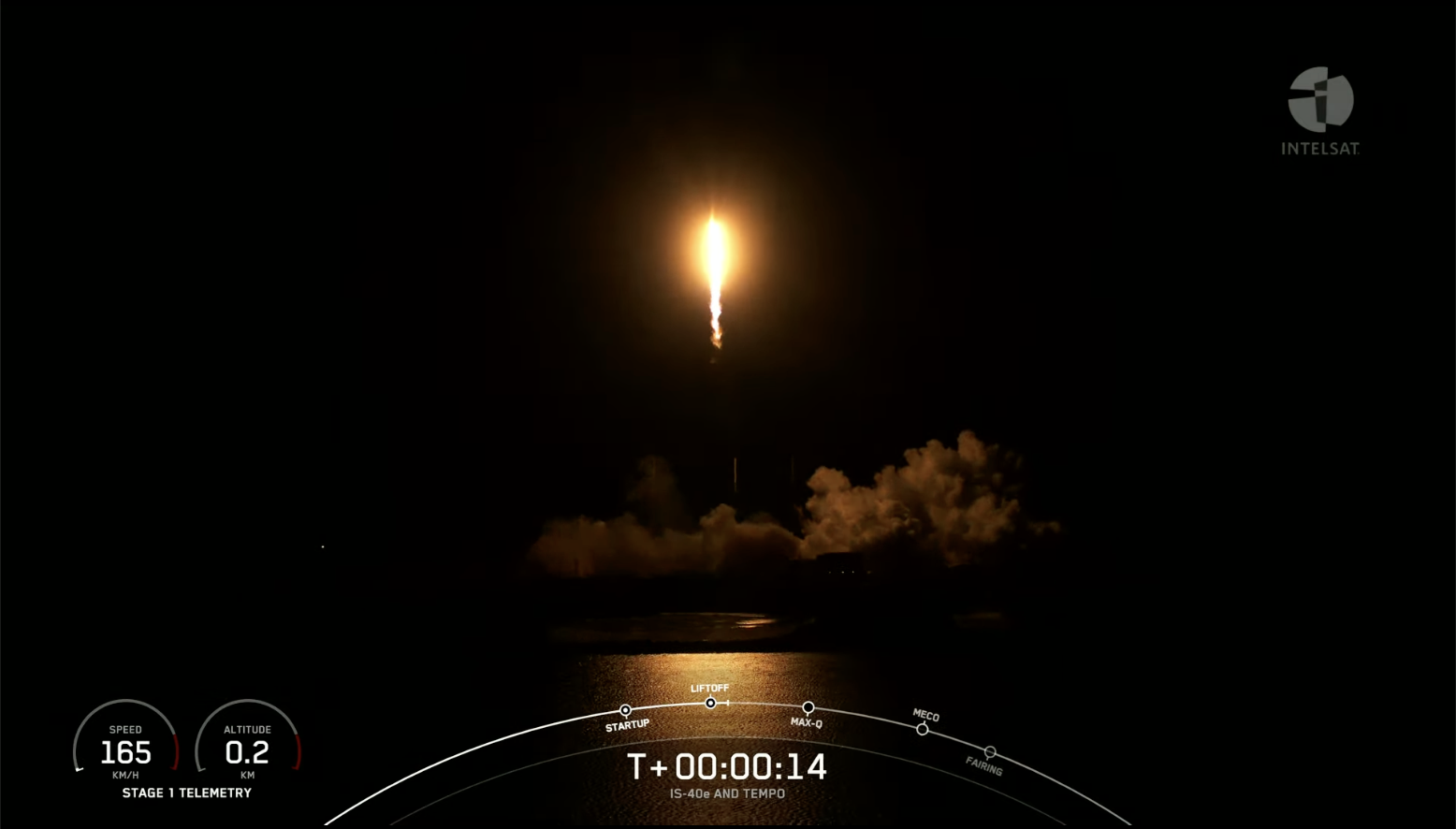
In 2022, it took SpaceX until the third week of June to pass 25 launches in a single year; two years ago, it took until the middle of November; and only as recently as 2020 did the Hawthorne, Calif.-headquartered organization first surpass a quarter-century of flights across the span of an entire calendar year. But with a significant uptick in launch cadence in 2023’s opening months—averaging a flight every 4.2 days—SpaceX is gearing up to pass 25 flights as early as mid-April, as the first of a trio of ambitious missions from the East and West Coasts of the United States went airborne just past midnight Friday, laden with a powerful geostationary communications satellite, co-hosted with a NASA-led payload devoted to high-resolution observations of atmospheric pollutants.
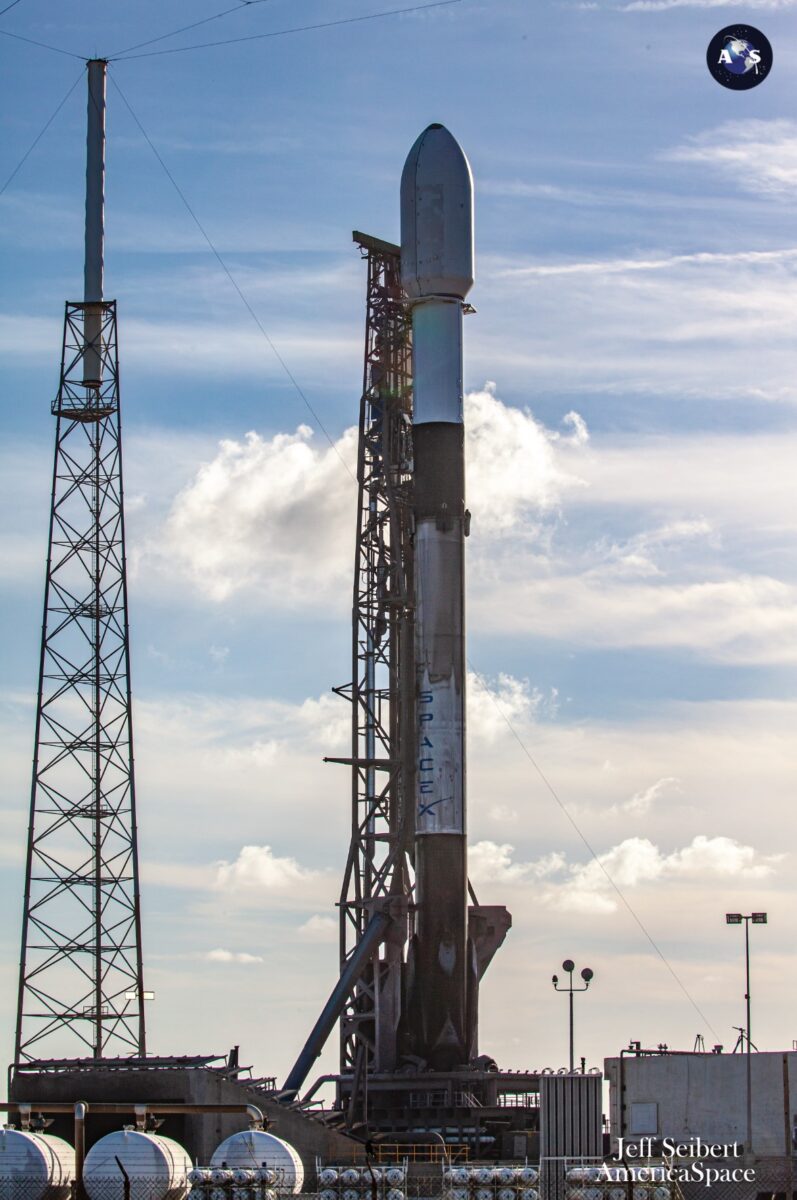
Friday’s 12:30 a.m. EDT liftoff from storied Space Launch Complex (SLC)-40 at Cape Canaveral Space Force Station, Fla., was the 23rd SpaceX mission of the year and its fifth geostationary-bound commercial communications customer since January. The flight of Intelsat 40e follows February’s launches of the Amazonas Nexus High Throughput Satellite (HTS) to cover the entirety of the American continents, Greenland and the North Atlantic Corridor and the “hybrid” Ka-/L-band Inmarsat-6 F2 to support communications across the business aviation, yachting, military and emergency disaster-relief sectors, as well as helping to facilitate global high-speed mobile broadband.

Last month, SpaceX also lofted the dual-stacked SES-18 and SES-19 communications satellites, which will provide digital television broadcasts to 120 million homes and help accelerate Luxembourg-based SES’ C-band clearing plan to meet a Federal Communications Commission (FCC) objective to free up spectrum for 5G terrestrial wireless services. Added to that list, SpaceX has flown 11 dedicated Starlink missions—totaling 552 flat-packed low-orbiting internet satellites—and more than 200 other commercial, military and scientific payloads for London, England-based OneWeb, the U.S. Space Force, NASA, a smorgasbord of international customers and the Space Development Agency (SDA).
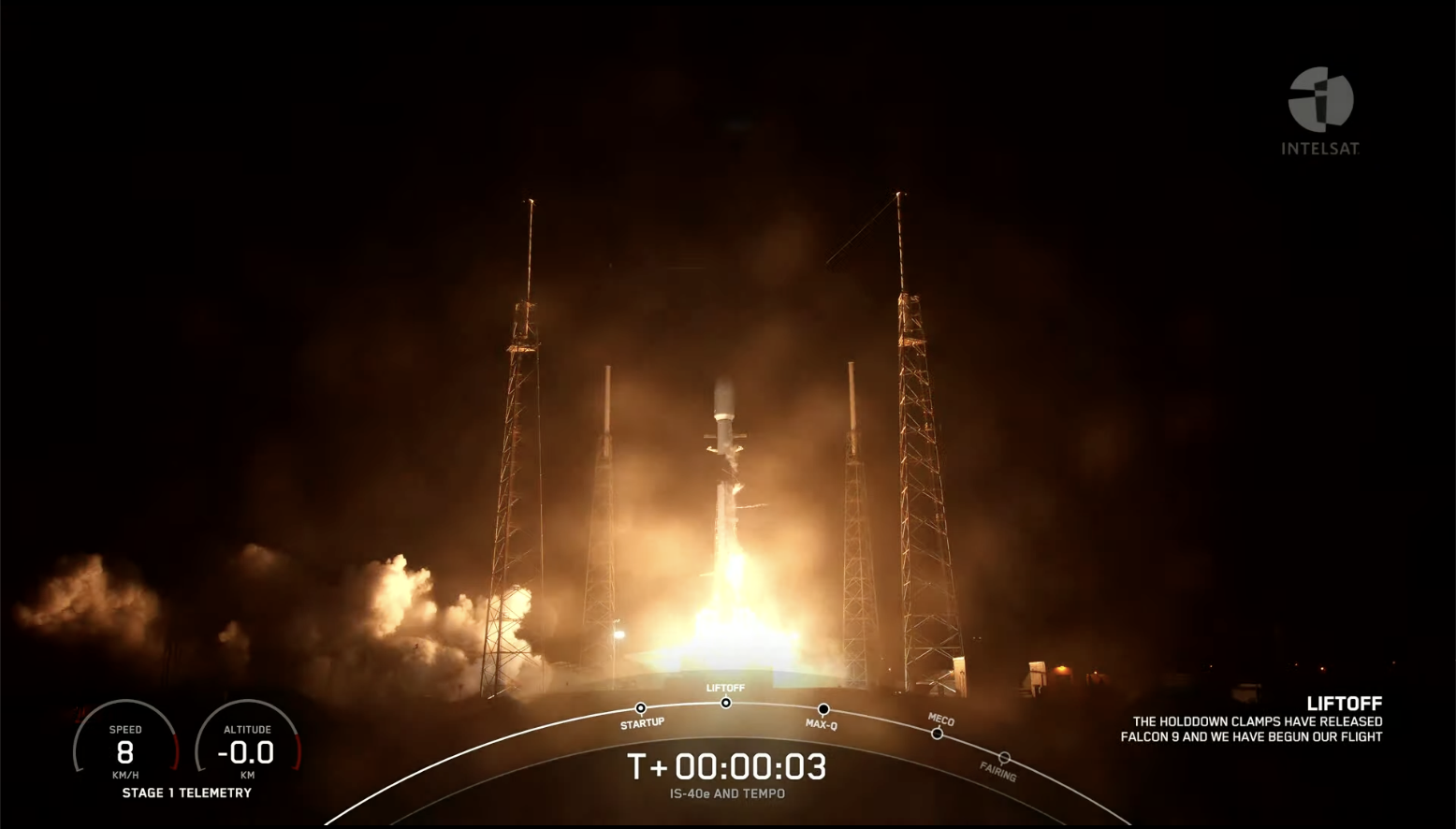
Aboard Friday’s flight was the Intelsat 40e High Throughput Satellite (HTS), which is co-manifested with NASA’s Tropospheric Emissions: Monitoring of Pollution (TEMPO), flying as an integrated “hosted” payload. Both spacecraft have been fabricated by Maxar Technologies, which won the TEMPO contract from NASA in July 2019 and the Intelsat 40e contract in February 2020, the latter of which marked the first of six Maxar satellites ordered by Intelsat in 2020.
Based upon Maxar’s 1300-class “bus”—which can accommodate up to 70 transponders and provide a payload power of 5-12 kilowatts continuously throughout a satellite’s operational lifetime—Intelsat 40e will provide coast-to-coast coverage across North and Central America and its transponder suite covers the C-band, Ku-band and Ka-band regions. This expansive capacity is expected to support a growing range of customers using Intelsat services for commercial and private aviation, the movement of vehicles on land and other mobility applications.
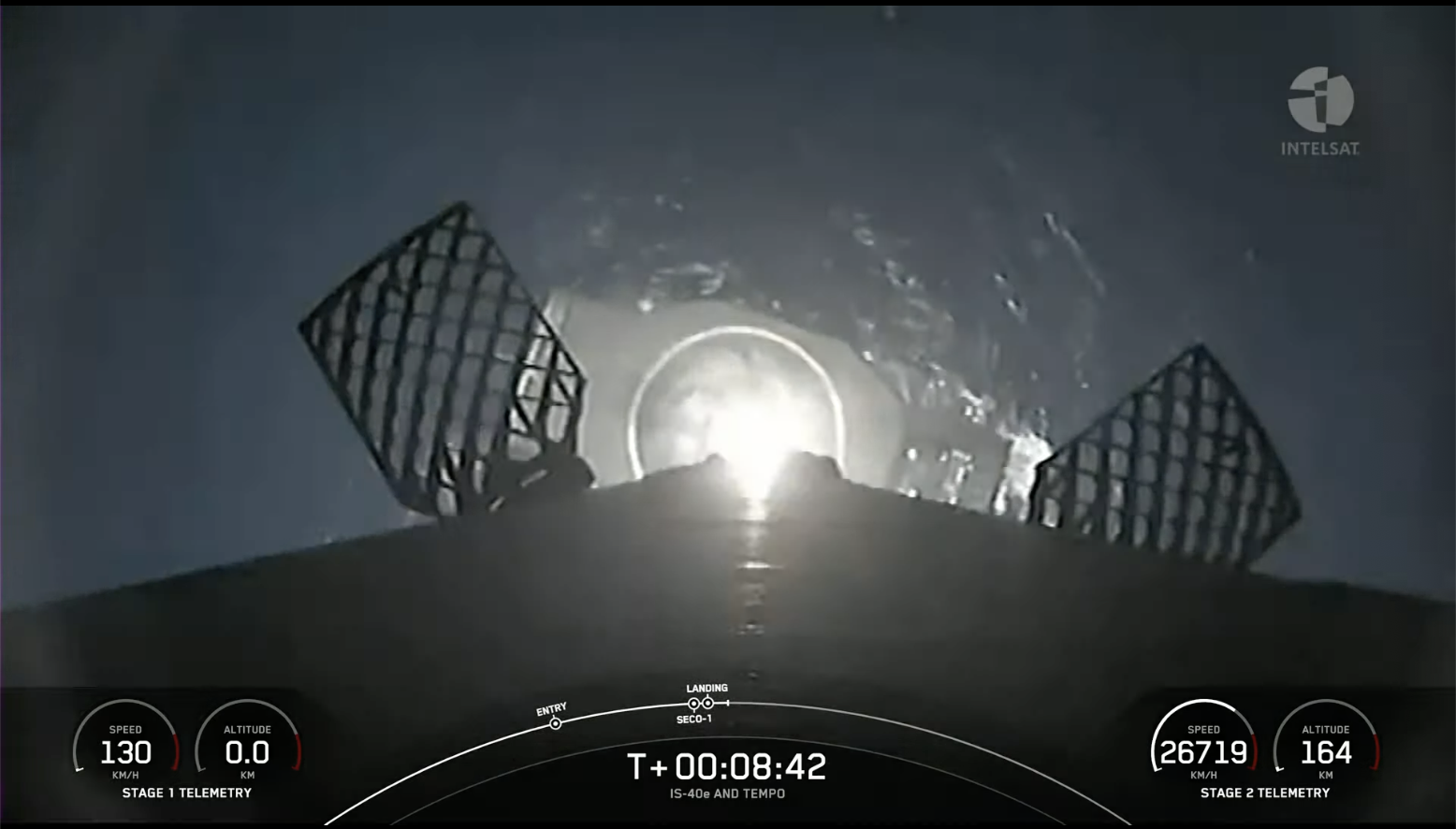
“Intelsat 40e will be the newest addition to our next-generation Intelsat Epic platform,” explained Intelsat CEO Stephen Spengler, “which is already providing our global customers with flexible, high-performance connectivity they can count on today and in the future.” According to Intelsat, the Epic platform “wraps a multitude of benefits”, including high performance and low cost, wide beams and spot beams for regional and application-specific requirements, an open architecture—with backward and forward compatibility for existing network infrastructure and anticipated future ground technology advances—as well as higher throughput, higher efficiency and greater availability via small terminals.
Flying as a co-hosted payload on Intelsat 40e is TEMPO, which comprises an ultraviolet/visible spectrometer to observe pollutants by measuring sunlight reflected and scattered from Earth’s surface and atmosphere. The instrument will complete first-of-its-kind hourly, east-west scans of the American continents, from Mexico to northern Canada and from the Atlantic to the Pacific seaboards, and its data is expected to aid air-quality forecasting and timely public warning of pollution-related incidents.
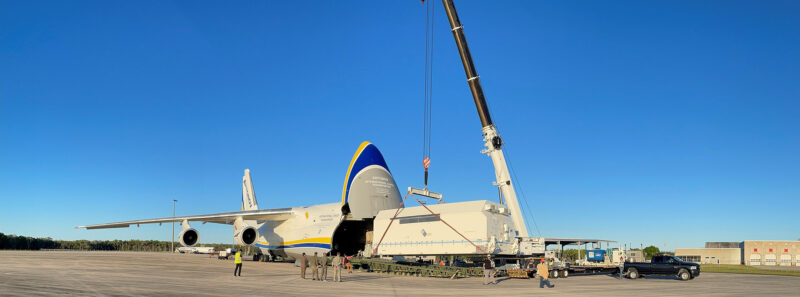
TEMPO can also be reconfigured to “dwell” over regions of specific interest, such as major fires or volcanic events. The payload was completed and flight-qualified in 2018 and NASA utilized the Air Force’s Hosted Payload Solutions (HoPS) program to solicit proposals from commercial entities to provide integration into a geostationary-orbiting “host” satellite, as well as launch services and ground operations.
Back in July 2014, the Space Command’s Space and Missile Systems Center (SMC) awarded an Indefinite-Delivery-Indefinite-Quantity (IDIQ) contract for HoPS to provide “a rapid and flexible means for the government to acquire commercial hosting capabilities” and the ability to house “up to approximately six hosted payloads”. It was noted that up to four Geostationary Earth Orbit (GEO) “lane” contract holders would receive study contracts to examine the feasibility of carrying TEMPO aboard one of their GEO satellites as a hosted payload, in a set of six-month contracts each valued at less than $800,000.
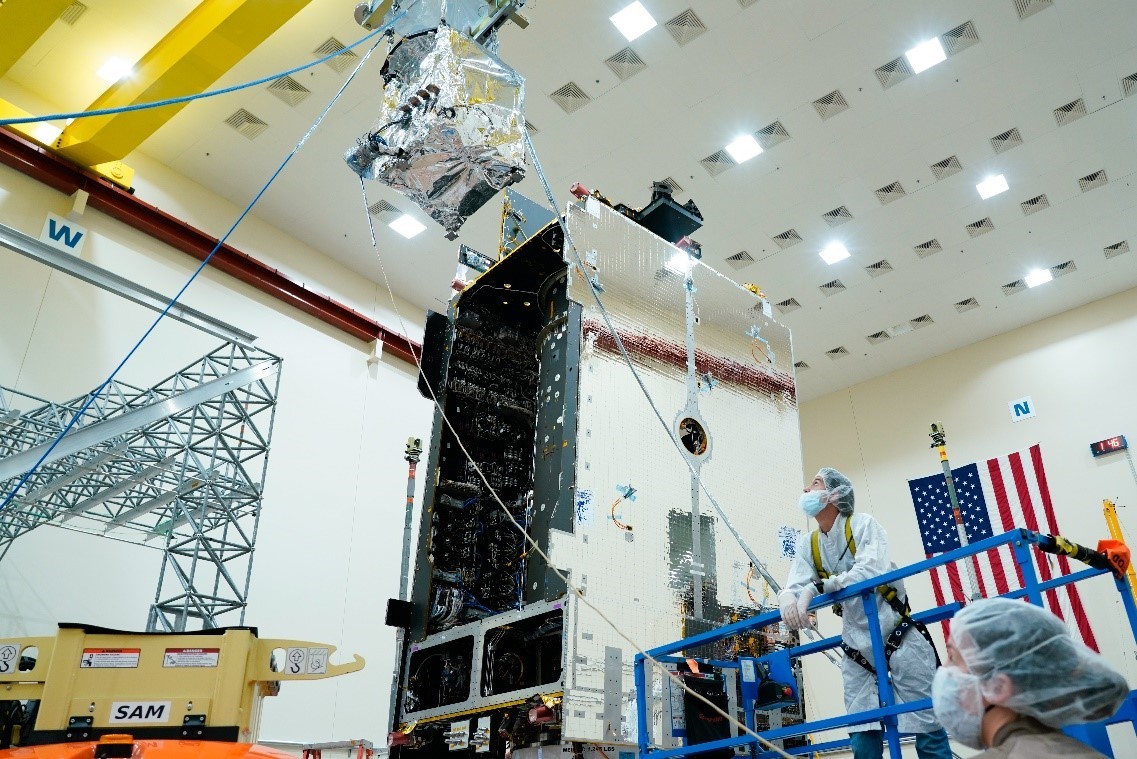
TEMPO’s primary instrument, built by Ball Aerospace at its Broomfield, Colo., facility, was delivered in May 2021 to Maxar’s site in Palo Alto, Calif., and in November of that same year was integrated aboard Intelsat 40e. Once fully integrated, the payload sailed through powered testing in June 2022.
“By hosting government payloads on our commercial satellites, Maxar can help government agencies access space without the cost of building a dedicated spacecraft,” Maxar reported in June 2021. “TEMPO…is a demanding payload on its host satellite but Maxar’s 1300-class spacecraft can support optical instruments with fine pointing, low-jitter and high-fidelity sensor data as either a hosted sensor or a dedicated mission.”
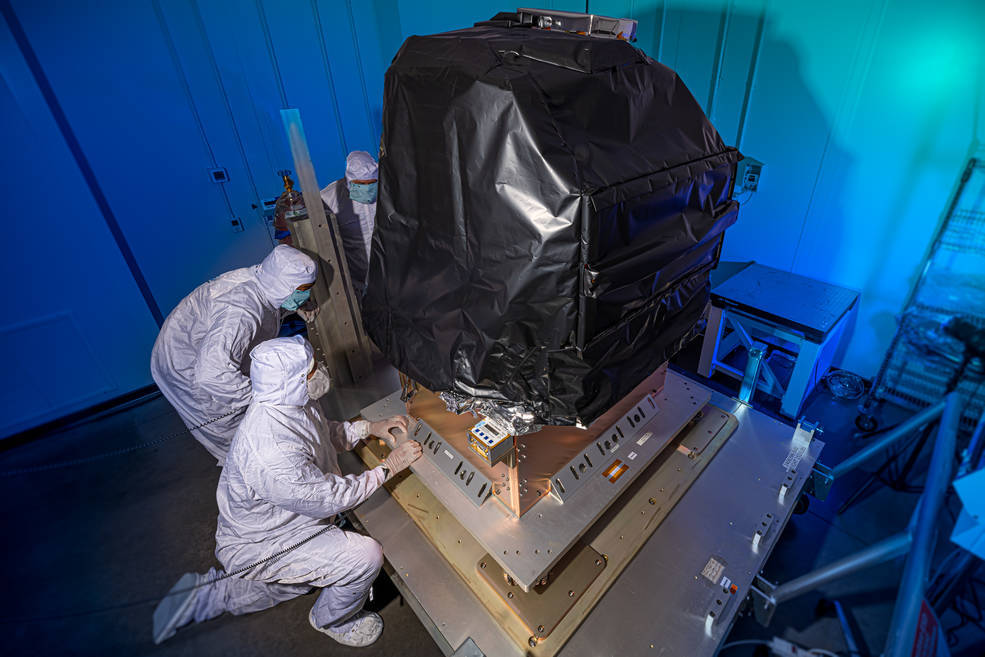
After wrapping up a punishing campaign of thermal-vacuum, dynamics and end-to-end capability testing in late February, Intelsat 40e/TEMPO arrived at the Kennedy Space Center (KSC) on 20 March for pre-launch processing. Destined for emplacement at 91 degrees West longitude at a geostationary altitude of more than 22,000 miles (35,000 kilometers), Intelsat 40e will be “co-located” with the Galaxy 32 communications satellite, which was launched atop another Falcon 9 booster late last fall.
The new satellite’s eventual vantage point will enable TEMPO to monitor daily variations in ozone, nitrogen dioxide and other key constituents of air pollution. Commands will be transmitted by the Smithsonian Astrophysical Observatory (SAO), via Intelsat custom-built software to TEMPO, instructing it where to scan and at what specific times.
When the launch services contract was awarded to SpaceX in March 2020, it was noted that Intelsat 40e/TEMPO would use “a flight-proven” Falcon 9 with a targeted No Earlier Than (NET) date of October 2022. That date subsequently slipped, firstly to no sooner than January 2023 and ultimately later into the spring.
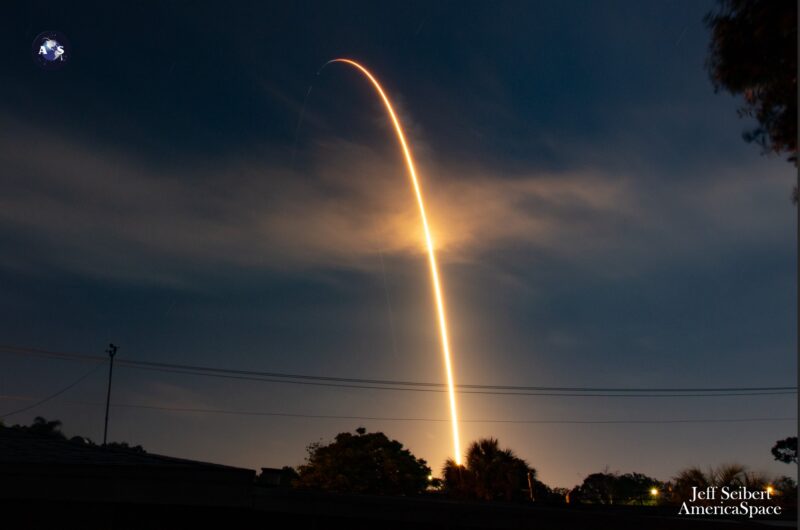
And the flight-proven booster for Friday’s pre-dawn launch was none other than three-times-flown B1076, which entered the SpaceX Falcon 9 fleet only last November to deliver the CRS-26 Cargo Dragon for a six-week berth at the International Space Station (ISS). With this morning’s launch, she also becomes only the second Falcon 9 core to log a third mission in 2023, having also ferried 40 broadband satellites uphill for OneWeb in January’s second week and the first 21 “downsized” Starlink V2 Mini satellites in late February.
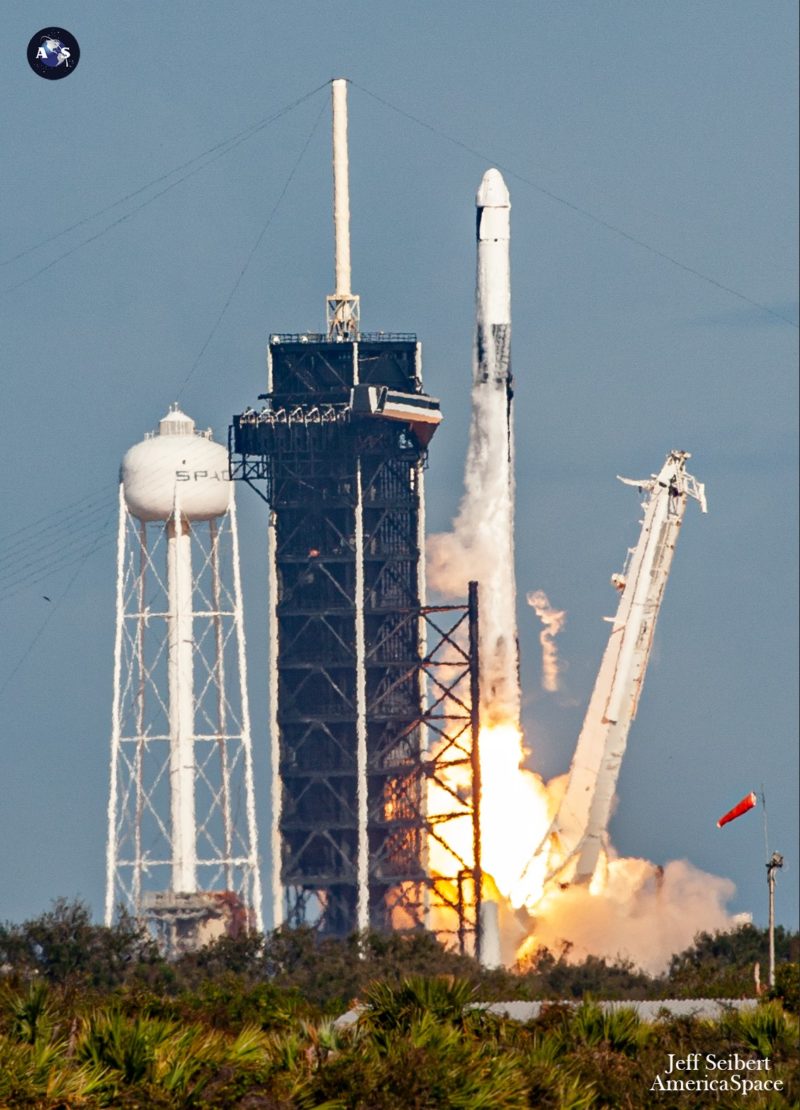
Weather conditions for Friday’s just-past-midnight launch were predicted to be highly favorable, with the 45th Weather Squadron at Patrick Space Force Base identifying a 90-percent Probability of Go (PGo) for the opening attempt, with a slight deterioration to 85 percent in the event of a slip to Saturday. Both days would enjoy expansive 119-minute “launch windows”: with Friday’s window opening at 12:30 a.m. EDT and that of Saturday opening at 12:29 a.m. EDT.
“A strong frontal system will be making its way across much of the Eastern U.S.,” the 45th noted in its Wednesday update, but added that the cold front would stall across the Deep South before reaching the Space Coast. “This will leave the Spaceport in an onshore flow pattern with moderated temperatures and isolated coastal showers,” it was added, producing a weather picture violated by a slight risk of breaching the Liftoff Winds Rule and the Cumulus Cloud Rule “associated with the gusty, onshore flow”.
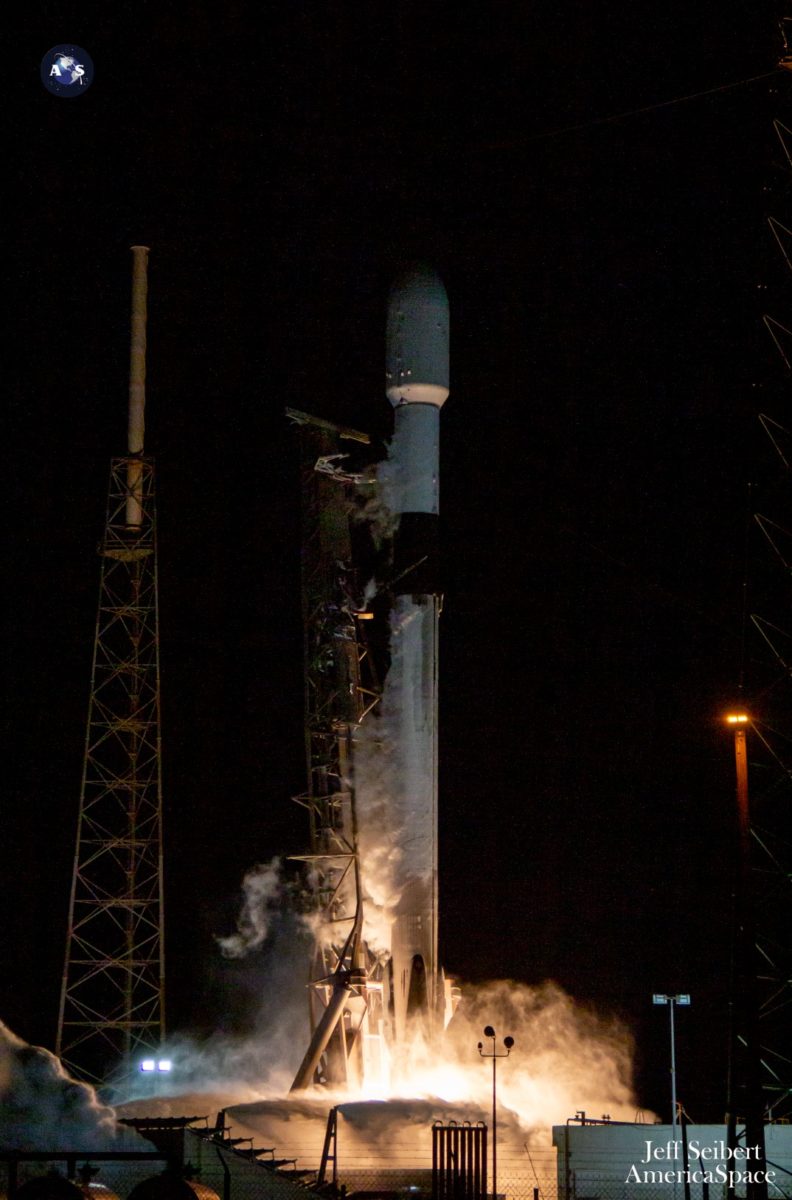
In readiness for launch, the Autonomous Spaceport Drone Ship (ASDS), “A Shortfall of Gravitas”, put to sea out of Port Canaveral last Sunday, bound for a position about 420 miles (670 kilometers) offshore in the Atlantic Ocean. Interestingly, on her outbound journey, she passed her fellow East Coast drone ship, “Just Read the Instructions”, which was heading back to port laden with the newly-retrieved B1077 core.
Following Friday’s successful 12:30 a.m. EDT liftoff, B1076 powered the 230-foot-tall (70-meter) Falcon 9 stack uphill for the first 2.5 minutes of ascent, before separating and returning to her own smooth touchdown on the expansive ASOG deck. Meanwhile, the Falcon 9’s second stage executed a pair of “burns” of its single Merlin 1D+ Vacuum engine to position the Intelsat 40e/TEMPO payload for deployment at 32 minutes after launch.
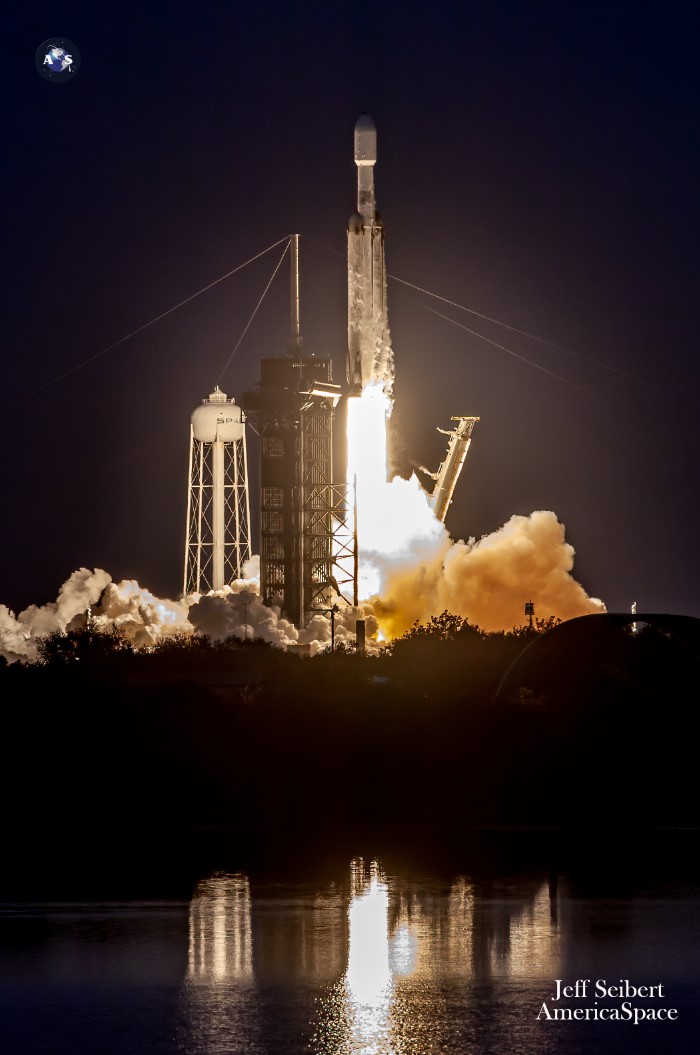
With its 23rd flight of the year complete, SpaceX can now look ahead to hitting the magic number of 25 around mid-April. Up next, possibly in the early hours of next Tuesday, will be the multi-payload Transporter-7 “rideshare” mission out of Vandenberg Space Force Base, Calif., with the second Falcon Heavy of the year—carrying the first of three ViaSat-3 ultra-high-capacity broadband satellites—expected to follow from KSC’s historic Pad 39A at 7:36 p.m. EDT on 18 April.
Although Transporter-7’s payload haul has yet to be determined, its multitude of CubeSats, smallsats and orbital transfer vehicles are expected to include clients with interests ranging from Earth observation to technology demonstrations, from Signals Intelligence (SIGINT) to weather forecasting and from Internet of Things (IoT) to education. And the first ViaSat-3, which tips the scales at nearly 13,000 pounds (6,000 kilograms), will utilize the Heavy’s immense muscle for direct insertion into a near-GEO orbital spot for an anticipated 15 years of operational service.
Each member of the ViaSat-3 Ka-band series of satellites will furnish more than one terabit per second—equivalent to 1,000 gigabits per second—of network capacity. This will deliver a global broadband network with sufficient bandwidth to deliver affordable, ultra-high-speed, high-quality internet and video streaming services.
The first ViaSat-3 will provide coverage of the Americas, with two follow-on satellites set to launch via ULA’s Atlas V and Arianespace’s Ariane 6 to focus on Europe, the Middle East and Africa (EMEA) and Asia and the Pacific (APAC). ViaSat contracted the ViaSat-3 Americas launch to SpaceX back in October 2018, with an expectation that it would fly in 2020-2022, although delays arose following the COVID-19 pandemic, together with contractor and supply-chain issues.
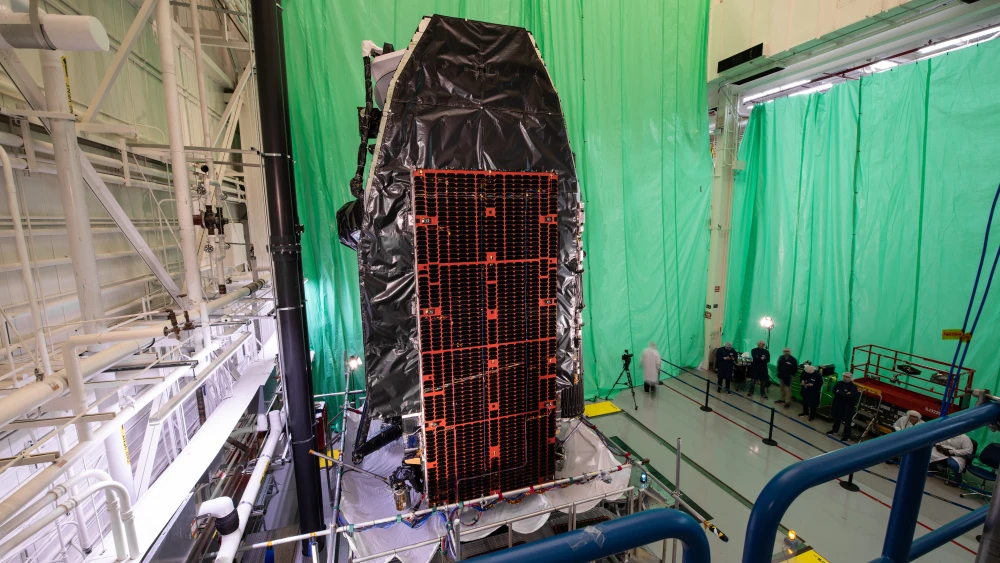
In June 2021, ViaSat announced that it had completed payload integration and performance testing at its Tempe, Ariz., factory and was ready to ship it to Boeing’s El Segundo, Calif., facility for integration into the satellite bus. Last September, ViaSat-3 Americas was fully integrated and by mid-October had completed its mechanical interface tests, ahead of its Final Integrated Satellite Test (FIST) late last November.
According to ViaSat, the Falcon Heavy was selected for the ViaSat-3 Americas launch on account of its ability to emplace the satellite extremely close to geostationary orbit. This will enable it to commence In-Orbit Testing (IOT) quickly, rather than spending weeks or months maneuvering to its optimum position.






6 Comments
6 Pings & Trackbacks
Pingback:Starship, Falcon Heavy and 50-Payload Falcon 9 Primed for Mid-April Launches - AmericaSpace
Pingback:Transporter-7 Mission Flies, Falcon Heavy to Launch Next Week - AmericaSpace
Pingback:As Starship Realigns for NET Wednesday, Falcon 9, Falcon Heavy Prepare for Upcoming Missions - AmericaSpace
Pingback:SpaceX Flies Year’s 25th Mission, Looks to Starship/Super Heavy Debut Tomorrow - AmericaSpace
Pingback:Starship, Falcon Heavy and 50-Payload Falcon 9 Primed for Mid ... - AmericaSpace - Digi90
Pingback:A Tale of Three Launch Sites: SpaceX Targets Falcon 9 Launch ... - AmericaSpace - Digi90